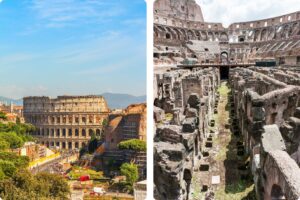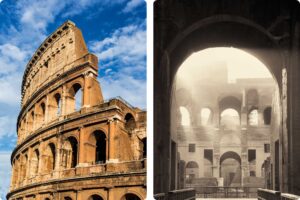One of Rome’s most iconic landmarks, the Colosseum was built as a large amphitheatre and completed in 80 AD under Emperor Titus. With a capacity of 50,000 to 80,000 spectators, the Colosseum hosted various events that have become legendary in Roman history. In this blog, we explore the famous spectacles and brutal games that took place in this iconic arena.
Gladiator Fights
The most famous events held at the Colosseum were the gladiator fights. Gladiators, often slaves, convicts, or prisoners of war, fought against each other or wild animals for the entertainment of the audience. These fights were incredibly violent and often ended in death. Gladiators could gain fame, and their fate was sometimes determined by the emperor or the crowd. A thumbs-up or thumbs-down gesture from the emperor would decide whether a defeated gladiator lived or died.
Hunting scenes (Venationes)
Another popular event in the Colosseum were the “venationes” or hunting scenes. In these spectacles, wild animals such as lions, tigers, bears, and elephants were pitted against gladiators or trained hunters. These events were a display of Rome’s dominance over nature and showcased the vast diversity of exotic animals that were brought into the city. Hundreds of animals were sometimes killed in a single day, and these events were immensely popular among the Roman public.
Executions (Damnatio ad bestias)
The Colosseum was also the site of public executions, known as damnatio ad bestias (condemnation to the beasts). Criminals were sentenced to be thrown into the arena, where they would be killed by wild animals. Some executions were even staged as reenactments of myths or legends, adding a theatrical element to the grim spectacle.
Re-enactments of famous battles
To entertain the public, the Colosseum also hosted reenactments of famous battles from Rome’s history. These were not actual battles but rather performances with actors. These reenactments also served as propaganda, glorifying Rome’s military power and showcasing the empire’s victories to the public.
Naval Battles (Naumachiae)
One of the most unique spectacles in the Colosseum were the naumachiae, or naval battles. These rare events involved flooding the arena to recreate famous sea battles, with small boats sailing through the flooded arena. The logistics of staging these naval battles were complicated, requiring a system to fill and drain the arena.
Plays and Mythical Stories
The Colosseum was also a venue for theatrical performances based on Roman myths and stories. These plays were sometimes staged in a very realistic manner, with actors performing death scenes, including being thrown from great heights or killed in dramatic ways as part of the myth being portrayed.
Celebrations and Events in Honour of the Emperor
The Colosseum frequently hosted major celebrations and events in honor of the emperor or military victories. When a new emperor came to power or after significant victories, weeks of games and spectacles were organized. In fact, the inaugural games of the Colosseum lasted for 100 days, showcasing the grandeur and wealth of the Roman Empire.
Public Events and Social Gatherings
Beyond violent spectacles, the Colosseum also served as a social hub where Romans of all classes could gather. The seating arrangement reflected social status: the elite enjoyed the best seats near the arena, while women and lower-class citizens were relegated to the upper tiers.
The End of the Games in the Colosseum
With the rise of Christianity and the decline of the Roman Empire, the games at the Colosseum gradually came to an end. By the 5th century AD, gladiatorial combat was officially banned.
Today, the Colosseum stands as a symbol of ancient Rome and its brutal history. It remains one of Rome’s most popular tourist attractions, offering visitors a glimpse into the empire’s spectacular and sometimes savage past.
Discover More About Rome and the Colosseum
Want to learn more about Rome and the Colosseum? Book the SmartWalk Rome to explore the city at your own pace. With this self-guided walking tour, you can take breaks whenever you want and discover the rich history of Rome, including the Colosseum and other must-see landmarks!






